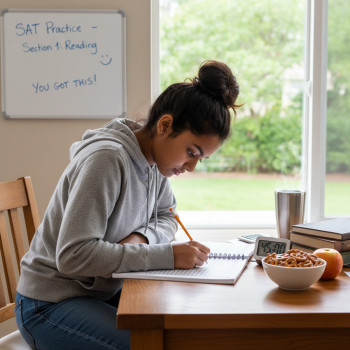When Should You Start Thinking About the SAT? A Short Answer
Start now — but not in a panic. “Now” means building awareness and a low-pressure plan in freshman year, with intentional skill-building and checkpoints through sophomore and junior years, and targeted test preparation in the 9–12 months before the intended test date. That phrasing balances two truths: the SAT rewards steady skill development, and last-minute cramming rarely produces calm confidence or peak results.

Why the timing matters (and why it’s not just about one test date)
People often treat the SAT like a single event to be conquered. In reality, it’s a milestone that reflects a student’s reading, reasoning, and math preparation accumulated over years. Starting early matters because:
- Skills accumulate. Vocabulary, reading stamina, algebra fluency and logic strengthen over time.
- Stress decreases. Spreading preparation across months or years avoids burnout and builds confidence.
- Options expand. Early planning gives families flexibility to choose when and where to test, and whether to retake.
- College strategy aligns. Knowing a student’s score trends helps shape realistic college lists and scholarship planning.
Freshman Year: Plant seeds, don’t sprint
Freshman year is the best place to start thinking — but mostly in gentle, constructive ways. This is the time to create a foundation without pressuring results.
What to focus on
- Academic habits: consistent homework routines, reading for pleasure, and participating in class.
- Course selection: take a challenging but manageable sequence in math and English to build necessary content.
- Diagnostic awareness: run a low-stakes diagnostic SAT or practice section late in the year to identify strengths and areas for growth.
Example: a student who reads widely for fun (novels, long-form articles, quality journalism) will naturally improve the reading comprehension and speed that the SAT tests.
Sophomore Year: Assess and begin targeted skill work
By sophomore year many families are ready to be a little more intentional. This is a great time to measure progress and begin directed practice.
Actionable steps
- Take a timed practice test under realistic conditions. Use the result to build a long-term plan—don’t obsess over the score.
- Strengthen core skills: practice algebra, geometry, and structured essay or evidence-based writing skills if needed.
- Explore prep options: occasional weekend courses, online modules, or trial tutoring sessions to see what fits your student.
At this stage, parents can support by helping their teen set small, measurable goals — for example, improving pacing in the reading section or mastering a set of algebraic strategies.
Junior Year: The heavy-lifting season (but still smart and balanced)
Junior year is when most students shift into focused SAT work. This is normal: colleges often see junior-year grades as the strongest academic signal, and test timing frequently falls in the spring or fall of junior year.
Timeline suggestions
- Spring of junior year: take or retake a full-length practice test to set a baseline.
- Summer before fall: consider an intensive prep block—6–12 weeks of steady work to build momentum.
- Fall of junior year: take an official Digital SAT date (or two) depending on readiness; review results and decide whether to retake in winter or spring.
Remember: many students improve significantly on a second or third official sitting when they use performance data to guide revision.
Senior Year: Final polishing and logistics
By senior year you want to be in refinement mode. If score goals are met and college applications are underway, focus shifts to submission logistics, final essays, and balancing stress.
When to stop retaking
- When scores hit target ranges for likely colleges and scholarships.
- When further practice yields diminishing returns or increases anxiety.
- When application deadlines make additional test dates impractical.
How many months of prep before an official test date?
There’s no one-size-fits-all timeline, but here are practical benchmarks based on different starting points:
| Starting point | Recommended prep period | Focus |
|---|---|---|
| Strong baseline score (near goal) | 6–8 weeks | Pacing, practice tests, targeted weak-point drills |
| Moderate baseline (needs 50–150 point gain) | 3–6 months | Systematic skill practice, weekly full-length practice tests, review cycles |
| Lower baseline (needs large gains) | 6–12 months | Core math/reading foundations, consistent tutoring or coursework, multiple practice-test cycles |
Daily and weekly routines that actually work
Consistency beats intensity. Here are routines that fit busy student lives without stealing childhood.
- Short daily practice: 20–40 minutes on a focused skill (vocabulary context, algebraic concepts, question types).
- Weekly full-section practice: once per week time a Reading or Math section to build stamina and pacing.
- One full practice test every 3–4 weeks during intense prep; fewer if you’re only polishing.
Quality matters more than quantity: well-reviewed explanations, targeted drills, and accurate problem deconstruction will beat random question sets.
How parents can support — without taking over
Emotional and logistical support from parents helps considerably. The challenge is offering the right help without adding pressure.
Do
- Create a calm study environment and regular schedule.
- Celebrate improvements — not just final scores.
- Help with logistics: registration, transportation, and healthy routines around test dates.
Don’t
- Turn the SAT into a family performance contest or measure of self-worth.
- Push excessive hours of last-minute studying that undercut sleep and performance.
- Micromanage every practice question — students need space to make and learn from mistakes.
Making sense of practice-test scores and retakes
Practice tests are data, not destiny. Use them to diagnose patterns (timing issues, specific content gaps, careless errors) and to measure the effect of targeted practice.
Plan retakes strategically: allow time after a test for deliberate practice targeted at the weak areas the test revealed. Many students see their biggest gains between two tests when the time between them is used well.
How digital SAT format changes the approach
The Digital SAT emphasizes adaptive testing, device-based delivery, and shorter sections. That affects preparation subtly but meaningfully:
- Practice on devices to build comfort with reading and marking digitally.
- Focus on time management in adaptive sections — early misses can change the question path.
- Work on keyboard-enabled inputs for the math section where relevant (depending on allowed tools).
Device familiarity reduces small friction points that can cost time and confidence on test day.
When to consider tutoring or a structured program
Tutoring or a structured prep program becomes valuable when self-study stalls or when personalized feedback is needed. Consider these signals:
- Plateauing scores after several months of study.
- Unclear patterns in practice-test mistakes.
- Need for accountability in a busy schedule.
Sparkl’s personalized tutoring can fit neatly here: 1-on-1 guidance, tailored study plans, expert tutors, and AI-driven insights help identify the highest-impact study moves and keep momentum without overwhelming the student.
Cost-effective ways to prepare
Good prep doesn’t have to be expensive. Mix and match free or low-cost resources with targeted paid help when needed:
- Free practice materials and sample tests for baseline and pacing.
- Targeted paid tutoring for persistent weak points or test anxiety.
- Group workshops or short-term bootcamps for structured review in the months before a test.
Balancing test prep with a full high-school life
College admissions look for well-rounded applicants. Sports, arts, volunteering, and strong junior-year courses matter alongside SAT scores. The right timing minimizes conflict:
- Avoid scheduling intensive prep during the busiest academic terms if possible.
- Use summers or lighter semesters for heavier test preparation.
- Keep mental health and sleep as priorities — both directly affect performance.
Real-world examples: timelines that worked
Example 1: Steady Improver
Maya started thinking about the SAT in freshman year, read widely throughout high school, took a diagnostic at the end of sophomore year, and completed focused tutoring the summer before junior year. She took two official tests in junior year and met her target score the second time.
Example 2: Late Starter with Smart Strategy
Ethan began prep in the spring of junior year after a baseline that showed math weaknesses. He committed to a 4-month plan: focused math practice, weekly timed sections, and three full practice tests. He improved significantly and used a targeted Sparkl tutoring plan for one month to polish pacing.
What to do in the month before a test
Taper intensity and sharpen focus:
- Do 1–2 full practice tests under timed conditions each week early in the month, then reduce to one in the final week.
- Drill targeted weaknesses (e.g., grid-in math, evidence-based reading) in short daily sessions.
- Finalize logistics: test center directions, device charging (if digital), and a restful sleep schedule.
What to do the week of the test
Prioritize calm and routine:
- Light practice: short drills but no heavy new learning in the last 48 hours.
- Set a bedtime that allows full rest, and eat balanced meals.
- Prepare materials and travel plans so there’s no rush on test day.
What parents should say (and not say) the night before
Helpful phrases: “You’ve prepared for this; do what you know how to do,” or “Focus on steady habits — you’ve got this.” Avoid creating pressure with comparisons or heavy consequences tied to one test.
Interpreting scores: beyond a number
Remember: the SAT score is one piece of a larger application puzzle. It matters for admissions and scholarships, but colleges also weigh grades, essays, recommendations, and extracurriculars. Use scores to inform decisions, not to define the student.
When scores don’t match expectations — recovery and next steps
It happens. If practice or official scores fall short, take a breath and follow a diagnostic plan:
- Review recent practice tests to find patterns (e.g., timing, careless errors, question types).
- Return to focused skill-building rather than redoing everything; precision beats repetition.
- Consider structured support for the next cycle — even a short block of personalized tutoring can change trajectory.
Closing thoughts: a practical, human timeline
Start early enough to build skills without pressure — freshman year for awareness, sophomore year for targeted skill work, junior year for focused preparation and test dates, and senior year for final decisions and logistics. The best plans are flexible, informed by real practice-test data, and respectful of a teen’s well-being.
If you’re unsure where to begin, a short diagnostic and a conversation about realistic timelines will pay off. Personalized programs — including options like Sparkl’s tutoring with 1-on-1 guidance, tailored study plans, expert tutors, and AI-driven insights — can provide clarity and momentum when families want focused support without the overwhelm.

Final checklist for parents
- Start discussions early — freshman year is a great time for awareness without stress.
- Use diagnostics to guide decisions rather than gut feeling.
- Plan prep time according to baseline scores and target improvements.
- Prioritize consistent, focused practice over last-minute intensity.
- Consider personalized tutoring when progress stalls or when accountability is needed.
- Keep the big picture in mind: the SAT is important, but it’s one part of a student’s story.
Good planning, steady habits, and thoughtful support will turn the SAT from a looming deadline into a manageable, even empowering, step on the path to college. Breathe, plan, and move forward — one small, steady step at a time.














No Comments
Leave a comment Cancel